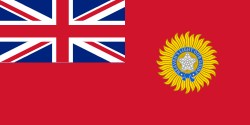Saugor and Nerbudda Territories
| Saugor and Nerbudda Territories | |||||
| Region of British India | |||||
| |||||
|
Flag | |||||
| History | |||||
| • | Territories captured by the British East India Company | 1818 | |||
| • | Merger of the Saugor and Nerbudda Territories and Nagpur Province | 1861 | |||
| | |||||
The Saugor and Nerbudda Territories was a region of British India, located in central part of present-day Madhya Pradesh state in central India. It included the present-day districts of Sagar (Saugor), Damoh, Jabalpur, and Narsinghpur.
The region extended on either side of the Narmada River (Nerbudda). Jabalpur (Jubbulpore) was the capital and the military headquarters of the territory. It was one of the candidates for the administrative capital of British India, when the Government decided to move the capital outside Calcutta in 1911.[1]
History
The Saugor and Nerbudda Territories were captured by the British East India Company from the Marathas at the conclusion of the Third Anglo-Maratha War in 1818. Saugor was the seat of a Maratha governor, and the northern portion of the territory was ceded by the Maratha Peshwa, the southern portion, which included Jabalpur and the upper Narmada ("Nerbudda") valley, was ceded by the Bhonsle maharaja of Nagpur.
Immediately after occupation the British authorities established a provisional administration under the superintendent of Political Affairs of Bundelkhand. In 1820 a division containing 12 districts was formed which was known as the Agency of the Saugor and Nerbudda Territories.[2] This new division was placed under an agent of the general governor at Jabalpur. In 1835 the Saugor and Nerbudda Territories were attached to the North-Western Provinces that had just been formed and which included the British Dominions in the southern portion of present-day Uttar Pradesh state.[3]
In 1842-1843, during the Bundela rising, two Bundela landlords rebelled against the British in Sagar district, spreading the unrest to Jabalpur District. Following the uprising the territory was placed again under the administration of an agent of the general governor, Sir W. Sleeman, but the arrangement did not work well and in 1853 the Saugor and Nerbudda Territories were reattached to the North-Western Provinces.[4]
In 1861 the Saugor and Nerbudda Territories were merged with Nagpur Province, which the British had annexed in 1853, in order to form the Central Provinces.[5]
See also
References
- ↑ Imperial Gazetteer of India, (New ed.), Oxford: Clarendon Press, 1908-1909. Vol. 10.
- ↑ Henry Harpur SpryModern India: With Illustrations of the Resources and Capabilities of Hindustan, Volume 2. London 1837
- ↑ History of Sagar
- ↑ Shiri Ram Bakshi, S.R. Bakshi & O.P. Ralhan eds., Madhya Pradesh Through the Ages.Sarup & Sons. pg. 12
- ↑ Philip F. McEldowney (1980). Colonial Administration and Social Developments in middle India: The Central Provinces, 1861-1921 - Ph. D. Dissertation. University of Virginia.
Coordinates: 23°10′N 79°56′E / 23.167°N 79.933°E
